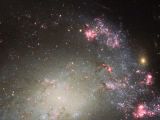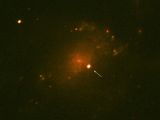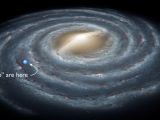The NGC 428 galaxy, discovered by German-born British astronomer William Herschel back in 1786, lies in the constellation of Cetus, at a distance of about 48 million light-years from Earth.
Scientists describe it as a barred spiral galaxy. Unlike run-of-the-mill spiral galaxies, barred ones have a distinctly shaped central bulge. Thus, their core region is shaped like a, well, bar. Mind you, our Milky Way is a barred spiral galaxy as well.
Recently, the Hubble Space Telescope pointed its Advanced Camera for Surveys and its Wide Field and Planetary Camera 2 at NGC 428 and obtained a gorgeous close-up shot of the galaxy.
The view, made public by NASA astronomers earlier this week, is available in the gallery below. It doesn't show the galaxy in its entirety, but instead only focuses on a region saturated with stars and clouds of dust.
“Bursts of pink and red, dark lanes of mottled cosmic dust, and a bright scattering of stars - this NASA/ESA Hubble Space Telescope image shows part of a messy barred spiral galaxy known as NGC 428,” reads the image's description.
NGC 428 likely collided with another galaxy not long ago
Although a barred spiral galaxy like our Milky Way, NGC 428 is ever so slightly deformed. Thus, astronomers describe its structure as being a tad warped. By comparison, other spiral galaxies display arms and cores neatly arranged in space.
It is believed that NGC 428 ended up being a cosmic Quasimodo of sorts in the aftermath of a collision that occurred not very long ago. Specifically, scientists believe that, at some point in its history, it smashed into another galaxy.
This would explain not just its odd shape but also why it is forming new stars at a rapid pace. “When galaxies collide their clouds of gas can merge, creating intense shocks and hot pockets of gas, and often triggering new waves of star formation,” astronomers say.
A couple of years ago, a supernova - i.e. a stellar explosion - was documented not far from NGC 428's core. A view of this supernova, identified as SN2013ct, is also included in the gallery below.

 14 DAY TRIAL //
14 DAY TRIAL // 


